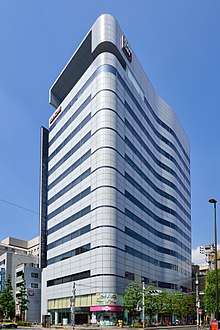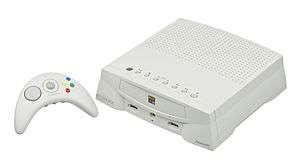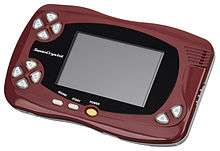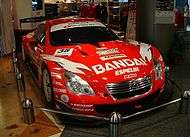Bandai
Bandai Co., Ltd.[lower-alpha 1] is a Japanese toy maker and a producer of many plastic model kits as well as a former video game company. It was the world's third-largest producer of toys in 2008 after Mattel and Hasbro.[2][3] Some ex-Bandai group companies produce anime and tokusatsu programs. Its headquarters are located in Taitō, Tokyo.[4]
 | |
 Corporate headquarters in Taitō, Tokyo | |
Native name | 株式会社バンダイ |
|---|---|
Romanized name | Kabushiki-gaisha Bandai |
| Subsidiary | |
| Industry | Toy |
| Founded | July 5, 1950 |
| Founder | Naoharu Yamashina |
| Headquarters | Taitō, Tokyo, Japan |
Key people | Masaru Kawaguchi (President) |
| Products |
|
Number of employees | 810 (August 2018)[1] |
| Parent | Bandai Namco Holdings |
| Website | http://www.bandai.com/ |
| Footnotes / references "Bandai Namco Group Integrated Report 2019". Bandai Namco Holdings. 13 September 2019. Archived from the original on 17 May 2020. Retrieved 17 May 2020. | |
History
In 1947, Naoharu Yamashina was working for the company of his brother-in-law, a textile wholesaler. As that segment of the market was going weak at the time, he realized about the potential of the toy industry. He successfully convinced his brother-in-law to dedicate a portion of the company's activities in that industry and to be in charge of it.[5] Step by step, Yamashina developed a toy distribution empire within the company. On July 1950, Yamashina took full control of the toy distribution business, renamed it and founded the company Bandai-ya (a Chinese phrase meaning "things that are eternal"[6]) whose name was eventually shortened to Bandai in 1961.[7][8][9]
In its first year, Bandai produced its first internal game, the Rhythm Ball,[10] and its first metallic toy, a reproduction of the B-26.[8] It also began the exportation of toys. As the company expanded, Bandai increased its exportations by building up in 1953 a new warehouse outside of Komagata. Several services were created within the company such as quality control, an R&D department and a transport division.[8]
In early 1955, Bandai founded the subsidiary Waraku Works, a manufacturing facility.[5][8] During the summer, Bandai moved to new headquarters in Taito-ku, not far from Komagata.[8] The first company logo was created using the initials "BC" based on the first letters of Bandai Company.[5][8] At the end of the year, Bandai launched its first product under guarantee, a mini replica of the Toyopet Crown car.[5][8][11]
In 1958, Bandai introduced its first television commercial using the slogan «The Red Box means a BC-guaranteed toy ».[5] In the middle of the following year, the company launched a lineup of mini toys representing car models from all over the world dubbed as "Cars of the World".[5][8] The company logo was redesigned to emphasize on the quality of Bandai's products and was known as the "Banzai mark".[5][8][11]
In the 1960s Bandai expanded to include international export sales. The management was handed to a new subsidiary created in New York called Bandai Overseas Supply.[5][9][12] Bandai's racing car set, which first appeared in 1962, became a huge success.
In 1963, Bandai separated the transportation service from the company to become its own subsidiary called Bandai Transport.[13] Due to an increase of activity volume, the company relocated to new offices in Asakusa, Taitō.[9] Bandai launched the toy Astro Boy, based on the character of the animated series.[9] It was the first time Bandai was creating a toy based on an existing hero.[9]
Bandai continued to expand in the 1970s with the creation of several subsidiaries; Tonka Japan in 1970 following a joint venture with Tonka,[14] Bandai Models being established in 1971, and finally Popy,[15], who specialized in the manufacturing of toy characters.[5][16] Although not their most profitable range, Bandai's 1/48 scale AFV models dominated that segment of the model kit market. Bandai America Inc. was established as local US sales/marketing operation in 1978. Spacewarp, a line of build-it-yourself toy rolling ball "roller coasters" was introduced by Bandai in the 1980s.
In May 1980, Makoto Yamashina, son of the founder, became president of Bandai. Naoharu Yamashina became chairman of the board. Upon his arrival, Makoto Yamashina completely changed the aging staff of Bandai and replaced it with young employees with the intent of not only bringing new ideas, but also revisiting the strategy of the group. The new president took a different commercial approach by selling directly to retailers rather than going through intermediates.[5][17]
In July 1980, Bandai launched the Gundam Plastic Model based on the animated series which gave birth to the Gunpla series.[18][19] In November, the subsidiary Celent was created.[17]
In November 1985, Bandai introduced the first video game based on the manga Kinnikuman: the NES title Tag Team Match: MUSCLE, which sold more than one million copies.[17]
Since the 1980s, Bandai has become the leading toy company of Japan, and to this day, has the main toy licenses in Japan to popular properties including Daikaiju, Ultraman, Super Robot, Kamen Rider, the Super Sentai and Power Rangers series (which they took part in creating), Gundam and many others.
The management of Bandai and Sega discussed a merger in the late 1990s and voted to implement it,[20][21] but the merger was later cancelled, citing "cultural differences", after a large scale protest by Bandai's middle management.[22][23] Makoto Yamashina stepped down as president immediately afterwards, stating, "I feel responsible for the troubles related to the merger."[24]
After its merger with game developer and amusement facility operator Namco in 2005, Bandai Company is now under the management and a member of Bandai Namco Holdings (Bandai Namco Group). Following a group reorganisation in 2006, Bandai heads the group's Toys and Hobby Strategic Business Unit (SBU).[25]
On February 2018, Saban Brands and Bandai's US division jointly announced a mutual agreement to not renew their Power Rangers master toy license, effective Spring 2019, after which competing toy company Hasbro will inherit the license. This transition will not affect Bandai Japan's Super Sentai master toy license with Toei.
A sister company, Bandai Spirits, was established on 15 February 2018. On 1 April 2018, the division of Bandai Co., Ltd that dealt with products for adult customers (including figures and plastic models) as well as Banpresto's prizes business were transferred over to Bandai Spirits.[26]
Organization
Before the formation of Bandai Namco Holdings, Bandai had many subsidiaries. After group reorganization in 2006, they are managed under several strategic business units (SBUs) of the group. Further detail:
Toys and Hobby SBU
Popy
In 1971, Bandai founded its subsidiary company Popy which helped to launch toylines such as Chogokin and Machine Robo. It was merged into its parent company in 1983.
Bandai America Inc.
Bandai America Inc. is the American distribution arm of Bandai that manufactures and distributes toy products for the U.S. market. Products include:
Original/Wholly-owned brands
- Aikatsu! (Japan only)
- Battle Spirits (Japan only)
- Cocotama (Japan only)
- Digimon
- Dinozaurs (Japan only)
- Harumika
- Hyper Cluster
- Locksies
- Mobile Suit Gundam
- Mugen Pop-Pop
- Pac-Man
- Pretty Pixels
- S.H. Figuarts
- Sprukits
- Tamagotchi
- Tamashii Nations
Present licences
- 44 Cats
- Anpanman (Japan only)
- Crayon Shin-chan (Japan only)
- Dragon Ball
- Doraemon
- Godzilla
- Kamen Rider (Japan only)
- Naruto (via Anime Heroes)
- One Piece (Japan Only)
- Pokémon (Japan only)
- Pretty Cure (Japan only)
- Sailor Moon (Japan only)
- Saint Seiya: Knights of the Zodiac (via Anime Heroes)
- Super Sentai (Japan only)
- Ultraman (Japan only)
- Yo-Kai Watch (Japan only)
Past licences
- Alienators: Evolution Continues
- Astro Boy
- Beetleborgs
- Big Hero 6
- Blue Dragon
- Ben 10 (2007-2016; merchandise now produced by Playmates)
- Cardcaptor Sakura
- Cyclonians
- Dick Tracy
- D.I.C.E.
- Final Fantasy VII
- Finding Dory
- Godaikin
- Jelly Jamm (English dub)
- Legends of Oz: Dorothy's Return
- Little Battlers Experience
- Magical DoReMi
- Mech-X4
- Metal Heroes
- Miraculous: Tales of Ladybug & Cat Noir
- Pocoyo
- Power Rangers (1993-2019; merchandise now produced by Hasbro)
- Strawberry Shortcake
- Tinga Tinga Tales
- Teen Titans
- The Tick
- The Mystic Knights of Tir Na Nog
- Ralph Breaks the Internet
- Ultimate Muscle
- Unazukin
- Wedding Peach
- Xyber 9: New Dawn
- Zak Storm
- Zatch Bell!
Visual and music contents SBU
Bandai Visual
Bandai Visual Co. Ltd., produces and distributes many popular anime and tokusatsu titles. These titles include Cowboy Bebop, Big O, Outlaw Star, Please Teacher!, Escaflowne, and the popular Gundam, Kamen Rider, Ultraman, and Super Sentai series. Their subsidiaries include the Emotion Music Company Limited, in which the logo is the Moai, a statue found on Easter Island. They now head the Visual and Music Contents SBU. Their North American division, Bandai Visual USA was absorbed into Bandai Entertainment (also a division of Bandai Visual) on 1 July 2008.
Bandai Entertainment
Bandai Entertainment was a subsidiary of Bandai Visual that was involved in the distribution of numerous anime in North America, as well as manga, American-made graphic novels and other merchandising ventures related to anime. Their headquarters in the United States were located in Cypress, California. They had a European subsidiary named Beez Entertainment (also a subsidiary of Bandai Visual) who handled European licensing & distribution rights to their library. The first part of Beez Entertainment's name stood for Bandai Entertainment European Zone, as Bandai Entertainment had operations in Europe. BEEZ Entertainment was based in France. Bandai Entertainment absorbed Bandai Visual's North American division, Bandai Visual USA, at the start of July 2008, and as a result, they were taken over by Bandai Visual, who then became their new parent company (though Bandai Entertainment continued to be part of Bandai). In addition, Bandai Visual also took over Beez Entertainment as their entry into the European market, and Beez Entertainment also continued to be part of Bandai as well.
However, Bandai Entertainment is no longer acquiring licences to new anime,[27] and as of 1 March 2013, they are no longer distributing and publishing home video in North America except for some.[28] Also, Beez Entertainment is no longer releasing new anime in Europe.[29]
Carddass
Carddass is the Bandai subsidiary responsible for releasing trading card games based on popular Bandai franchises. This includes games such as the Gundam War Collectible Card Game based on the Gundam metaseries, as well as a Gash Bell (Zatch Bell!) TCG, Naruto CCG, Rangers Strike (Super Sentai series, Kamen Rider series, Metal Hero series), Neon Genesis Evangelion Ultra Galaxy Daikaijyu Battle (Ultra series) and most recently their most successful to date, the Battle Spirits Trading Card Game.
Sunrise
Game contents SBU
Bandai Games (now Bandai Namco Entertainment as of 2015)
Bandai Games produced and distributed video games based on Bandai properties including Mobile Suit Gundam: Zeonic Front, Gundam Wing: Endless Duel and Mobile Suit Gundam: Journey to Jaburo.
In the early 1990s, Bandai published games for Nintendo in the United Kingdom, including Street Fighter II on the Super Nintendo Entertainment System.[30]
In the beginning of 2005, Bandai Games opened a United States office as a wholly owned subsidiary of Bandai America which, prior to that, handled the publishing of video games in North America itself.
On 31 March 2006, it merged with Namco Ltd. which was renamed Bandai Namco Games Inc.
Consoles

During the late 1970s, Bandai sold the TV Jack console line: a series of pong based consoles. The last of the series was the Bandai Super Vision 8000 console released in 1979. It wasn't a simple pong based console system but a cartridge system with an 8-bit NEC D780C (Z80 clone) as CPU.
During the early 1980s, Bandai distributed a number of videogame machines. In 1982 the Bandai Arcadia, a variant of the Emerson Arcadia 2001, was released in Japan by Bandai. There were also four Japan-exclusive game releases which were the only known Arcadia titles written by other companies than UA Ltd. They also released local variants of the Intellivision and Vectrex game consoles.
Bandai has also distributed several consoles from Nintendo to Europe (UK and France) from 1987 including the Super Nintendo Entertainment System and Game Boy.
Bandai produced a running mat called the Family Fun Fitness System for the Nintendo Entertainment System starting in 1986. A series of games was released both in the US and in Japan, including Athletic World and Stadium Events for the NES. Shortly after its release, Nintendo purchased the rights to the FFF mat in North America, replacing it with their own redesign, the Power Pad. In order to maintain branding continuity, Stadium Events was pulled from shelves after a short period of availability at Woolworth's stores. Because the game was pulled from shelves and discontinued before many copies were sold, Bandai's Stadium Events is universally accepted as the rarest licensed NES game released in North America.[31][32] A shrink wrapped copy of the game sold for $41,270 on eBay in February 2010.[33] The sister game to Stadium Events, called Athletic World was initially released with a label that indicated compatibility with the Family Fun Fitness mat, but was later re-released with an updated label that mentions the Power Pad instead.[34] Stadium Events was not released by name again, but instead was slightly modified and relaunched as the Power Pad pack-in game, World Class Track Meet.
In the 1990s, Bandai teamed up with Apple to make the Pippin. They also made their own game console, the Playdia. Neither was a mass-market success. In 1999, Bandai created the WonderSwan portable game system. It, and its update, the WonderSwan Color, sold modestly well, but were unable to seriously challenge the dominant Game Boy Color and later, the Game Boy Advance. It was discontinued in 2003.
Handheld systems

Bandai has also released a series of handheld game consoles including the WonderSwan, WonderSwan Color and Swan Crystal. The systems were only released in Japan.
Bandai has also released a series of LCD games including Tuttuki Bako (released in Japan in 2008) and the LCD Solarpower series (released in the 1980s in both regions).
Games developed/published by Bandai
- Beam Galaxian
- Gun Professional
- Missile Vader
- Othello
- PacPacBird
- Space Fire
- Submarine
- LSI
- Missile Invader[35]
- LCD
- Patsy Duck
- Sailor Moon
- Sailor Moon Heart
- Anpanman
- Gundam: Luna Tsu no Tatakai
- Mac OS
- Bishōjo Senshi Sailor Moon S Quiz Taiketsu! Sailor Power Kesshuu
- Bishōjo Senshi Sailor Moon SuperS Sailor Moon to Hiragana Lesson!
- Bishōjo Senshi Sailormoon SS Sailor Moon to Hajimete no Eigo
- Bishōjo Senshi Sailormoon SS Youkoso! Sailor Youchien
- Mighty Morphin Power Rangers
- Mighty Morphin Power Rangers: The Movie
- SD Sengokuden 2: Tenka Touitsu Hen
- Welcome Nakayoshi Park
- Kaijū-ō Godzilla
- Adventures of Gilligan's Island
- Akuma-kun: Makai no Wana
- Athletic World
- Bandai Golf: Challenge Pebble Beach
- Chubby Cherub
- Dick Tracy
- Dig Dug II[36] (The NES version of Dig Dug was only released in Japan, until the Wii Virtual Console release in the US in June 2008.)
- Dr. Jekyll and Mr. Hyde
- Dragon Power
- Dragon Spirit
- Dragon Spirit: The New Legend
- Dynowarz
- Frankenstein: The Monster Returns
- Galaga
- J. League Super Top Players
- Legends of the Diamond (Typo on the top label states Legends of the Daimond [sic])
- Monster Party
- M.U.S.C.L.E.
- Ninja Kid
- Shooting Range
- Stadium Events (Later pulled from shelves and retooled as World Class Track Meet)
- Street Cop
- Super Team Games
- The Rocketeer
- Toxic Crusaders
- Xevious
- Power Rangers Samurai
- Tamagotchi Connection: Corner Shop
- Tamagotchi Connection: Corner Shop 2
- Tamagotchi Connection: Corner Shop 3
- Sega Genesis
- Bishōjo Senshi Sailor Moon S Kurukkurin
- Bishōjo Senshi Sailor Moon S Kondowa Puzzle de Oshioikiyo!
- Bishōjo Senshi Sailor Moon SuperS Fuwa Fuwa Panic
- Bishōjo Senshi Sailor Moon Sailor Stars Fuwa Fuwa Panic 2
- Captain Tsubasa J: The Way to World Youth
- Dragon Ball Z Super Butoden
- Dragon Ball Z Super Butoden 2
- Dragon Ball Z Super Butoden 3
- Gon
- Kamen Rider
- Mazinger Z
- Mighty Morphin Power Rangers
- Mighty Morphin Power Rangers: The Fighting Edition
- Mighty Morphin Power Rangers: The Movie
- Panic in Nakayoshi World
- Power Rangers Zeo: Battle Racers
- Ruin Arm
- Shōnin yo Taishi wo Idake!!
- Ultraman: Towards the Future
- Captain Tsubasa J: Get In The Tomorrow
- Countdown Vampires
- Digimon World
- Digimon World 2
- Digimon World 3
- Digimon Rumble Arena
- Dragon Ball:Final Bout
- From TV Animation - One Piece: Grand Battle! 2
- Kids Station: Bishōjo Senshi Sailor Moon World Chibiusa to tanoshii mainichi
- Samurai Deeper Kyo
- Silent Bomber
- Scooby-Doo Arcade
- .hack
- D.I.C.E.
- Digimon Rumble Arena 2
- Digimon World 4
- Eureka Seven vol.1: New Wave
- InuYasha: Feudal Combat
- Mobile Suit Gundam: Encounters in Space
- Mobile Suit Gundam: Federation vs. Zeon
- Mobile Suit Gundam: Journey to Jaburo
- Mobile Suit Gundam Seed: Never Ending Tomorrow
- Mobile Suit Gundam: Zeonic Front
- Mobile Suit Gundam: Gundam vs. Zeta Gundam
- MS Saga: A New Dawn
- Naruto: Ultimate Ninja series
- One Piece Grand Battle!
- One Piece: Pirates' Carnival
- Zatch Bell! Mamodo Battles
- Zatch Bell! Mamodo Fury
- Ultraman Nexus
- Nintendo GameCube
- One Piece Grand Battle!
- One Piece: Pirates' Carnival
- Zatch Bell! Mamodo Battles
- Zatch Bell! Mamodo Fury
- Digimon Rumble Arena 2
- Digimon World 4
- Digimon Rumble Arena 2
- Digimon World 4
- Jelly Jam
- Mechamato
Notes
- Japanese: 株式会社バンダイ Hepburn: Kabushiki gaisha Bandai
References
- "About Company". Bandai. Archived from the original on 30 January 2019. Retrieved 21 April 2020.
- Cendrowicz, Leo (28 January 2008). "Lego Celebrates 50 Years of Building". TIME. Retrieved 21 September 2011.
- Solomon, Brian (4 September 2014). "Everything Is Awesome: Lego Leaps Barbie For World's Largest Toy Maker". Forbes. Retrieved 21 April 2020.
- "Bandai Group Establishes 'Bandai Channel' to Distribute Broadband Content". Bandai Group. 4 March 2004. Archived from the original on 3 March 2018. Retrieved 16 March 2010.
- "History of Bandai Co., Ltd". FundingUniverse. Retrieved 21 April 2020.
- Grant, Tina, editor (2003). International directory of company histories. Vol. 55. St. James Press. ISBN 978-1-55862-696-6. OCLC 1135347712.CS1 maint: multiple names: authors list (link)
- "Bandai Co Ltd". Bloomberg.com. Retrieved 21 April 2020.
- "Bandai's History: 1950's". Bandai. Archived from the original on 23 February 2011. Retrieved 21 April 2020.
- "Bandai's History: 1960's". Bandai. Archived from the original on 23 February 2011. Retrieved 21 April 2020.
- "Namco and Bandai Merger". Vending Times. 2 May 2005. Archived from the original on 8 January 2018. Retrieved 21 April 2020.
- "Bandai: the empire of games or factory of dreams?". MyMarketing.net. 22 January 2010. Archived from the original on 7 March 2014. Retrieved 21 April 2020.
- "Bandai Overseas Supply". chello.nl. Archived from the original on 1 September 2011.
- "Bandai Logipal Inc". Bloomberg.com. Retrieved 21 April 2020.
- "Tonka historique". StefGarage (in French). Retrieved 21 April 2020.
- "ToyboxDX Guide to Chogokin and Popinika". Alen Yen's ToyboxDX. Retrieved 21 April 2020.
- "Bandai's History: 1970's". Bandai. Archived from the original on 23 February 2011. Retrieved 21 April 2020.
- "Bandai's History: 1980's". Bandai. Archived from the original on 24 February 2011. Retrieved 21 April 2020.
- "30 ans de Gunpla, de 1980 à 2010". Gundam-France.com (in French). Archived from the original on 10 June 2012. Retrieved 21 April 2020.
- Ashcraft, Brian (11 May 2010). "Where Are Gundam Plastic Models Made?". Kotaku. Retrieved 21 April 2020.
- "Bandai and Sega band together". CNET. 23 January 1997. Retrieved 30 December 2016.
- "Sega, Bandai to merge into entertainment giant". The Japan Times. 23 January 1997. Retrieved 30 December 2016.
- Pollack, Andrew (28 May 1997). "Acquisition of Bandai by Sega Called Off". The New York Times. Retrieved 30 December 2016.
- Plunkett, Luke (9 August 2011). "When Sega Wanted to Take Over the World (and Failed Miserably)". Kotaku. Retrieved 30 December 2016.
- "Other Bandai Happenings". Electronic Gaming Monthly. No. 97. Ziff Davis. August 1997. p. 18.
- "Toys and Hobby SBU". Bandai Namco Holdings. Archived from the original on 29 May 2010. Retrieved 30 December 2016.
- "Notice Regarding Reorganization of Subsidiaries". Bandai Namco. 9 February 2018. Retrieved 21 April 2020.
- Loo, Egan (2 January 2012). "Bandai Entertainment to Stop Releasing New DVDs, BDs, Manga". Anime News Network. Retrieved 2 January 2012.
- Hodgkins, Crystalyn (31 August 2012). "Bandai Entertainment to Discontinue Home Video, Manga, Novel Sales". Anime News Network. Retrieved 31 August 2012.
- Loo, Egan (5 January 2012). "France's Beez Entertainment Stops Releasing New Anime". Anime News Network. Retrieved 21 April 2020.
- "Streets Ahead". N-Force. No. 6. December 1992. Retrieved 30 December 2016.
- "Original Nintendo Stadium Events Cartridge". Gamesniped.com. 30 May 2008. Retrieved 13 August 2012.
- "Wii Feature: 25 rarest Nintendo games ever". ComputerAndVideoGames.com. 29 June 2008. Archived from the original on 1 July 2008. Retrieved 13 August 2012.
- Smith, Mike (26 February 2010). "Rare Nintendo game is $40,000 windfall". Yahoo! Games. Archived from the original on 2 March 2010. Retrieved 21 April 2020.
- "Variant labels for NES games". Retrogaming Roundtable. 18 October 2007. Retrieved 13 August 2012.
- "Missile Invader by Bandai". Retrogames. Retrieved 23 March 2019.
- "Dig Dug II: Trouble in Paradise". Moby Games. Retrieved 21 April 2020.
External links
| Wikimedia Commons has media related to Bandai. |

